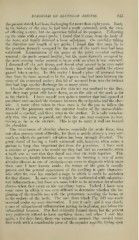Page 933 - My FlipBook
P. 933
DIAGNOSIS OF ALVEOLAE ABSCESS. 943
the patient stated, had been discharging for more than eight years. Early
in the history of the case he had had a tooth extracted, with the view
of effecting a cure ; but the operation failed of its purpose. Following
up the sinus with a small probe, I found that it came from the body of
the bone, and iinally detected a loose substance. On carefully taking
the direction and length of my probe, I found that this must be in
the position formerly occupied by the roots of the tooth that had been
extracted. Examination of the gums at the point revealed nothing
unusual ; the parts seemed healthy, but the space formerly occupied by
the now missing molar seemed to be as wide as when it was removed.
I dissected off the soft tissue, and found what seemed to be very solid
bone ; but with the first stroke with the chisel and mallet the chisel
passed into a cavity. In this cavity I found a piece of necrosed bone
that from its form seemed to be the septum that had been between the
roots of the extracted molar ; this bit of necrosed bone was the irritant
that had kept up this discharge for so many years.
Alveolar abscesses opening on the skin are not confined to the face,
but they may point still lower down, as on the side of the neck as far
as the clavicle. I have myself seen quite a number that had opened at
one-third and one-half the distance between the os hyoides and the clav-
icle. A route often taken in these cases is for the pus to follow the
fibres of the platysma until the anterior border of the sterno-cleido-
mastoid is reached, and there come to the surface. It is only occasion-
ally that this point is passed, and then the pus may continue its bur-
rowing as far as the clavicle. This is apt to carry it well out toward
the shoulder.
The DIAGNOSIS of alveolar abscess, especially the acute form, does
not often present much difficulty, for there is nearly always a very sore
tooth to which the ])atient's attention has been strongly directed. The
great dread of having a tooth extracted wnll, however, often cause a
patient to keep that important fact from the physician. I have seen
a number of patients who would say they had had no toothache, when
a tooth was so sore that they dared not close the teeth together. This
fact, however, hardly furnishes an excuse for treating a case of acute
alveolar abscess as one of erysipelas—an error in diagnosis which more
than once I have known made ; the tumor of the gum is usually
present and the general appearance of the swelling is quite character-
istic after the case has reached a stage in which it could be mistaken
for that disease. In some cases it might be confounded with subperios-
teal inflammations, but these are more liable to be mistaken for alveolar
abscess when they occur on the maxillary bones. Indeed, I have seen
some cases in which it was very difficult to determine whether the be-
ginning of the trouble w^as with the periosteum covering the bones or
in the sockets of the teeth. The case from which Fig. 503 was made
occurred under my own observation. I saw it early, and it was clearly
a case of subperiosteal inflammation having its beginning just below the
infraorbital foramen. Pus had evidently formed there, but the patient
very positively refused to have anything done ; and when I saw him
again, a few days later, there was extensive necrosis that carried away
four teeth with a considerable piece of the superior maxilla, laying open


